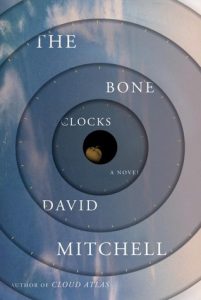The Bone Clocks by David Mitchell
 David Mitchell is a wonderful storyteller, a man considered one of the greats among living authors. I had previously read Cloud Atlas and regard it as one of the best books I have ever read. My experience with The Bone Clocks has only cemented my high opinion of Mitchell.
David Mitchell is a wonderful storyteller, a man considered one of the greats among living authors. I had previously read Cloud Atlas and regard it as one of the best books I have ever read. My experience with The Bone Clocks has only cemented my high opinion of Mitchell.
Its structure hews closely to the formula of Cloud Atlas. The Bone Clocks is a series of a half-dozen interlaced novellas, each chronologically forward from the previous. They are loosely tied together by the character of Holly Sykes (the narrator of the first one) and by a mysterious ongoing war between two magic-using factions. The fantasy elements of the book are understated but powerful through the first four novellas, and are the primary focus of the fifth. While technically fantasy (and it won a World Fantasy Award for best novel in 2015), you are more likely to find The Bone Clocks in the literature section of your local bookstore.
Mitchell’s writing is brisk and witty, filled with surprising and colorful images, unexpected metaphors, and immensely clever dialogue. Beyond the writing itself, his greatest talent is his authentic investment in his characters, making them feel absolutely real despite their variety. If verisimilitude were a substance, it would be pouring out of the book in waves. He transitions from a 15-year-old rebellious love-struck girl, to a charming early-20’s sociopath, to a bitter war correspondent, to a curmudgeonly middle-aged author, with perfect finesse.
(He uses the author character to tweak fun at himself and his critics at once. Minor spoiler: the author, Crispin Hershey, is reeling from a scathing review of his latest work. The review includes this):
”The fantasy sub-plot clashes so violently with the book’s State of the World pretensions, I cannot bear to look…What surer sign is there that the creative aquafers are dry than a writer creating a writer-character?”
The final novella is a jarring take on the apocalyptic consequences of society’s blind eye toward climate change and inveterate addiction to fossil fuels. It’s powerful, sobering, and believable.
 If I had to level one criticism at the book (and I do so with great misgivings, given Mitchell’s stature), it’s that the style of his writing, so immensely colorful and modern, doesn’t change between one character and the next. Normally this wouldn’t bother me a bit, but each of the novellas is narrated in first person, by very different characters. (In 3rd-person narration, a consistent narrator’s voice would be fine, as long as the dialogue and inner thoughts of each character were distinct.) Reading such disparate souls telling their stories in such uniform language—even though that language is delightful—smudged the diamond a bit for me.
If I had to level one criticism at the book (and I do so with great misgivings, given Mitchell’s stature), it’s that the style of his writing, so immensely colorful and modern, doesn’t change between one character and the next. Normally this wouldn’t bother me a bit, but each of the novellas is narrated in first person, by very different characters. (In 3rd-person narration, a consistent narrator’s voice would be fine, as long as the dialogue and inner thoughts of each character were distinct.) Reading such disparate souls telling their stories in such uniform language—even though that language is delightful—smudged the diamond a bit for me.
It’s still a diamond, though. I enjoyed Cloud Atlas a bit more, but The Bone Clocks joins it on my list of favorite novels.
Postscript: I read Mitchell’s Slade House immediately after finishing The Bone Clocks. The former is a small companion piece, a side-story running concurrent with the narrative of the latter. That reading order significant changes the experiencing of reading Slade House, but I’d still recommend reading The Bone Clocks first. Either way: read them both!
